
Markdown is a lightweight markup language that makes it easy to format and present content for the web. It uses plain text and simple syntax to keep everything straightforward—we have a handy Markdown cheat sheet you can print for reference.
While any plain text editor will work for Markdown, there are also dedicated Markdown editors for displaying and converting your writing into beautiful HTML, PDF, and beyond. Some of these are free, others are cheap, and some work with other tools to make Markdown more appealing.
Here are six of the best Markdown editors and tools for Mac users.
1. MacDown
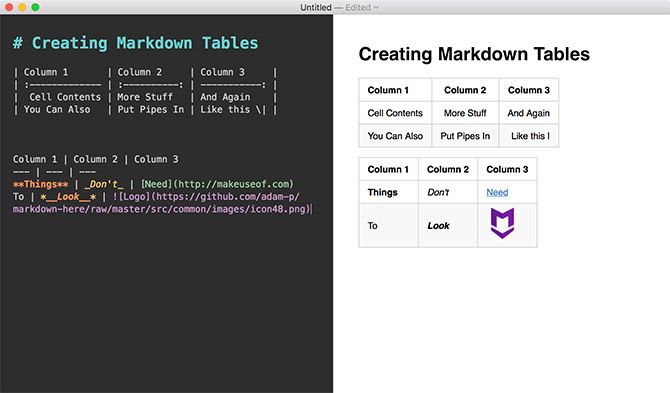
MacDown is a free and open source Markdown editor based on Mou. It surfaced when Mou’s developer ceased work on the project, sparking the idea to create a free editor that mimicked much of Mou’s features and functionality. The two projects are separate ventures, with MacDown steaming ahead in terms of development.
This is a Markdown editor that isn’t so much focused on code as it is writing. It uses a simple two-pane code view and rendered Markdown view to display changes in real-time. There’s the usual syntax highlighting you’d expect from an editor of its kind, and the editor offers a surprisingly good amount of customization.
This includes changes to the core functionality, allowing you to toggle non-standard Markdown extensions like tables, strikethroughs, and fenced code blocks. There are a ton of light and dark themes to choose from. Plus it has the ability to tweak editor appearance including line spacing and base font.
You can also change rendering style by picking from the included CSS or installing your own stylesheets. Rendering options are limited to HTML and PDF, with a handy Copy HTML feature for pasting directly into your projects.
Download: MacDown (Free)
2. Typora
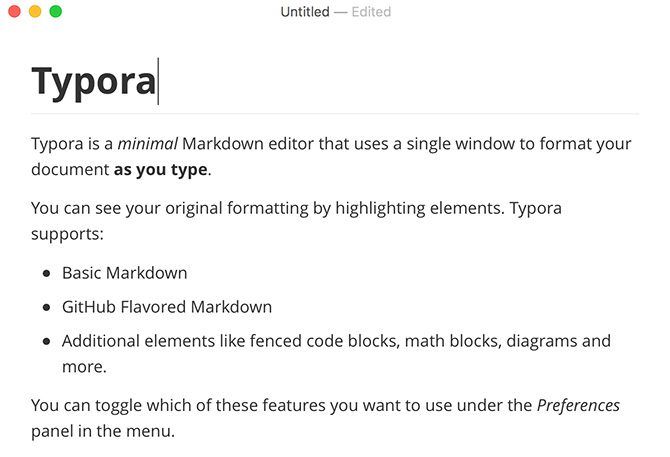
If you’re not keen on the two-pane approach of most Markdown editors, check out Typora. It’s an editor that makes working with Markdown more visually appealing, using a seamless live preview rather than a separate window. Syntax converts into formatted text as you type, so what you see is what you get.
Typora supports basic Markdown, GitHub Flavored Markdown, and some interesting additional elements like sequence, flowchart, and mermaid diagrams. You can configure your choice of syntax via the preferences menu, which provides plenty of opportunity to tweak the editor to your liking.
There’s very little on-screen while you’re composing your masterpiece. That makes this ideal for those who enjoy distraction-free writing experiences. Building on this there’s also a typewriter mode (which always keeps the cursor in the middle of the screen) and focus mode (which dims paragraphs you’re currently not working on).
Choose from six included styles, or add your own by copying the relevant stylesheets into the themes folder. In addition to the usual HTML and PDF export, Typora can also convert to Microsoft Word, OpenOffice, RTF, ePub, LaTeX, and image formats (among others).
There’s no online sync, so if you use multiple platforms you’ll need to provide your own cloud solution. Typora is currently free while in beta, and it’s available for macOS, Windows, and Linux.
Download: Typora (Free)
3. Atom
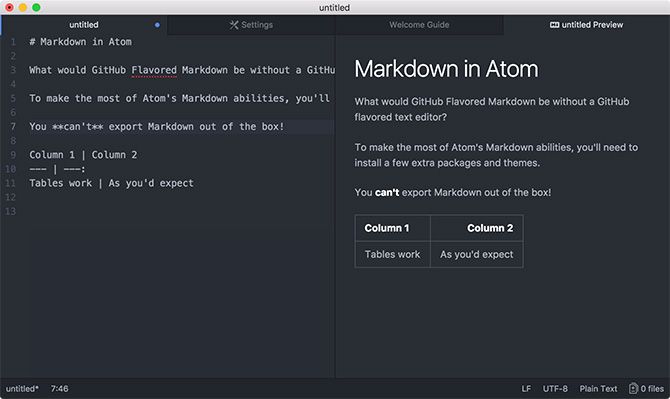
Atom is GitHub’s own plain text editor for scripting, coding, and writing GitHub Flavored Markdown. It’s a fairly simple app with Markdown support out of the box, albeit a little barebones for writers. It takes the standard two-pane preview window approach, with a Markdown Preview option found under the Packages menu.
Out of the box you’d be forgiven for discounting Atom, but there’s a lot more potential when you pair it with the right add-ons. A quick search of the package repository yields a healthy number of extensions that make Atom a force to be reckoned with when working with Markdown.
These include conversion tools to HTML, PDF, and image formats. You’ll also find support for other flavors beyond GitHub Flavored Markdown, toolbar plugins, table of contents generators, better image support, and tools for improved tables.
It’s a great solution if you already use Atom, or are looking for a plaintext editor you can also use for scripting or other programming purposes. Atom also enjoys great theme support, so you can get your editor looking just the way you like it. Just search for and install themes within the editor.
Atom is completely free as part of GitHub’s efforts to provide a tool that makes coding accessible to all. It might not be the most user-friendly approach, but it’s a robust and powerful tool in the right hands. Visual Studio Code is another great free alternative to Atom that’s also worth checking out.
Download: Atom (Free)
4. Caret
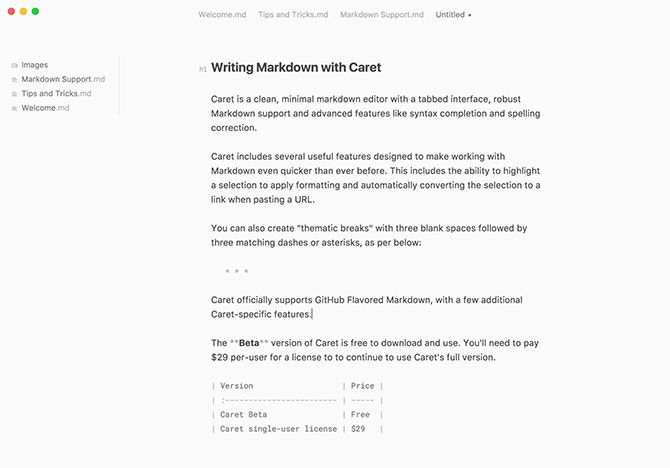
Caret is another minimal Markdown editor, with a clean interface and emphasis on productivity. It uses tabs to keep all relevant documents close at hand, with a main editor that displays both the syntax and the resulting formatted text. It’s a great way to learn Markdown, since your syntax is always visible, but you can also enable a preview pane if you want.
Caret officially supports GitHub Flavored Markdown, including tables, math blocks, and indented code blocks. It also packs a few unique features, like the thematic break accessible with three spaces and three identical dashes or asterisks.
The sidebar displays a folder’s contents, with your active documents appearing along the top edge of the editor. There’s a macOS Spotlight-like Go To tool for quickly jumping to a file or section of your document, a dark mode, and typewriter mode too.
Caret’s developers built it with speed in mind. It features assistance for building tables, auto-completion of file paths, emoji, and HTML. You also get spelling correction and multiple cursors—a feature normally reserved for powerful text editors.
Caret exports to HTML and PDF, and the beta version is free (though it’s not clear what the limitations to this version are). You can buy a license for $29 to continue to use Caret and support development efforts.
Download: Caret (Free trial, $29)
5. Ulysses
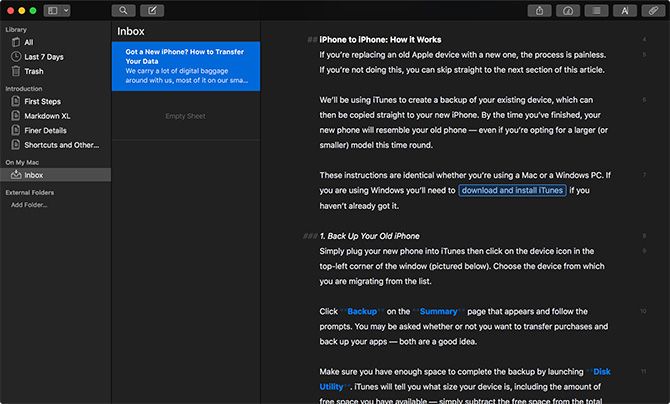
Ulysses is a full-fat writing app, with some seriously powerful features. It’s the sort of app you’ll want to use if writing is your livelihood, with its distraction-free and minimal approach to producing prose. It uses Markdown in a bid to make writers more productive, removing the need to take your eyes off the text to apply formatting or create headers.
Like Caret, Ulysses takes a hybrid approach to markup. Your syntax is still visible while writing, but so too is the formatting that this markup applies to your text. Links appear in-line, and bold and italics are both emphasized. You have the ability to customize how these elements appear in the app’s preferences.
For working with Markdown, you can choose from regular Markdown and what Ulysses calls Markdown XL. This adds additional syntax for elements like videos, annotations, comments, block quotes, and more. Some themes let you change how the editor displays your elements, plus you have the opportunity to create your own themes.
Ulysses really comes into its own when it comes to exporting your writing. There are themes available for exporting beautiful HTML and PDF documents, but also support for ePub and Microsoft Word. Cloud support via iCloud or Dropbox means you can work on the same documents using different devices (including iOS devices). Versioning support ensures you can revert to a backup if needed.
As a pure writing and publishing tool, Ulysses has the most to offer of all apps featured here. However, you might not need everything Ulysses offers, so a free option might suit you just as well. Ulysses uses a subscription model with a 14-day free trial, then $5 per month. You can also get Ulysses as part of the Mac app subscription service Setapp.
Download: Ulysses (Free trial, $5 monthly/$40 yearly)
6. Marked 2
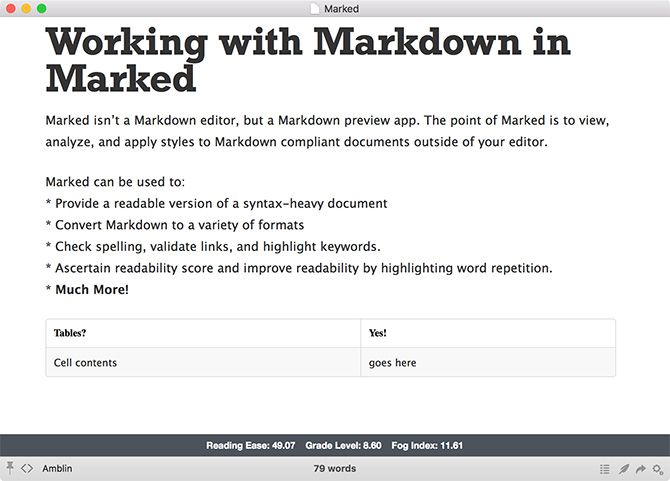
Marked 2 isn’t actually an editor, but a Markdown preview tool. That means you won’t use Marked to create documents, but it can turn just about any other text editor into a Markdown editor. The preview the app generates updates every time you save your file, or you can use it as a proofreading tool for files you’ve already created.
The app includes a wide array of processing and rendering options for getting the look you want. You can customize Marked with your own CSS to match your blog, so you know how your articles will look as you write them. You can also use the built-in readability, spellcheck, and link validation tools to make sure your work is up to scratch.
Marked also includes a table of contents panel for working with especially long documents, generated using your headings. The app is compliant with Markdown, GitHub Flavored Markdown, and even includes support for custom processors so coders can use the app with their own syntax.
Export options are extensive, with support for nine built-in themes (with the option of adding your own). Formats include PDF, RTF, Microsoft Word, and OpenOffice. You can try Marked for free before you buy, then pay $14 for the full version. It’s also available on Setapp.
Download: Marked 2 (Free trial, $14)
Don’t Forget Your Favorite Mac Text Editors
You don’t need a fancy Markdown editor to work with Markdown. A plain text editor works too. Your favorite editor will do, whether it’s Sublime Text, Visual Studio Code, or Vim. Check out our favorite plaintext editors for Mac if you’re looking for inspiration.
Read the full article: The 6 Best Mac Markdown Editors for Everyone
from MakeUseOf https://ift.tt/2OCOnjM
via IFTTT

0 comments: